Challenges towards Economic Fuel Generation from Renewable Electricity: The Need for Efficient Electro-Catalysis
DOI:
https://doi.org/10.2533/chimia.2015.789Keywords:
Electrochemical water splitting, Energy storage, Hydrogen, Oxygen evolution reactionAbstract
Utilizing renewable sources of energy is very attractive to provide the growing population on earth in the future but demands the development of efficient storage to mitigate their intermittent nature. Chemical storage, with energy stored in the bonds of chemical compounds such as hydrogen or carbon-containing molecules, is promising as these energy vectors can be reserved and transported easily. In this review, we aim to present the advantages and drawbacks of the main water electrolysis technologies available today: alkaline and PEM electrolysis. The choice of electrode materials for utilization in very basic and very acid conditions is discussed, with specific focus on anodes for the oxygen evolution reaction, considered as the most demanding and energy consuming reaction in an electrolyzer. State-of-the-art performance of materials academically developed for two alternative technologies: electrolysis in neutral or seawater, and the direct electrochemical conversion from solar to hydrogen are also introduced.Downloads
Published
2015-12-16
How to Cite
[1]
F. L. Formal, W. S. Bourée, M. S. Prévot, K. Sivula, Chimia 2015, 69, 789, DOI: 10.2533/chimia.2015.789.
Issue
Section
Scientific Articles
License
Copyright (c) 2015 Swiss Chemical Society

This work is licensed under a Creative Commons Attribution-NonCommercial 4.0 International License.







